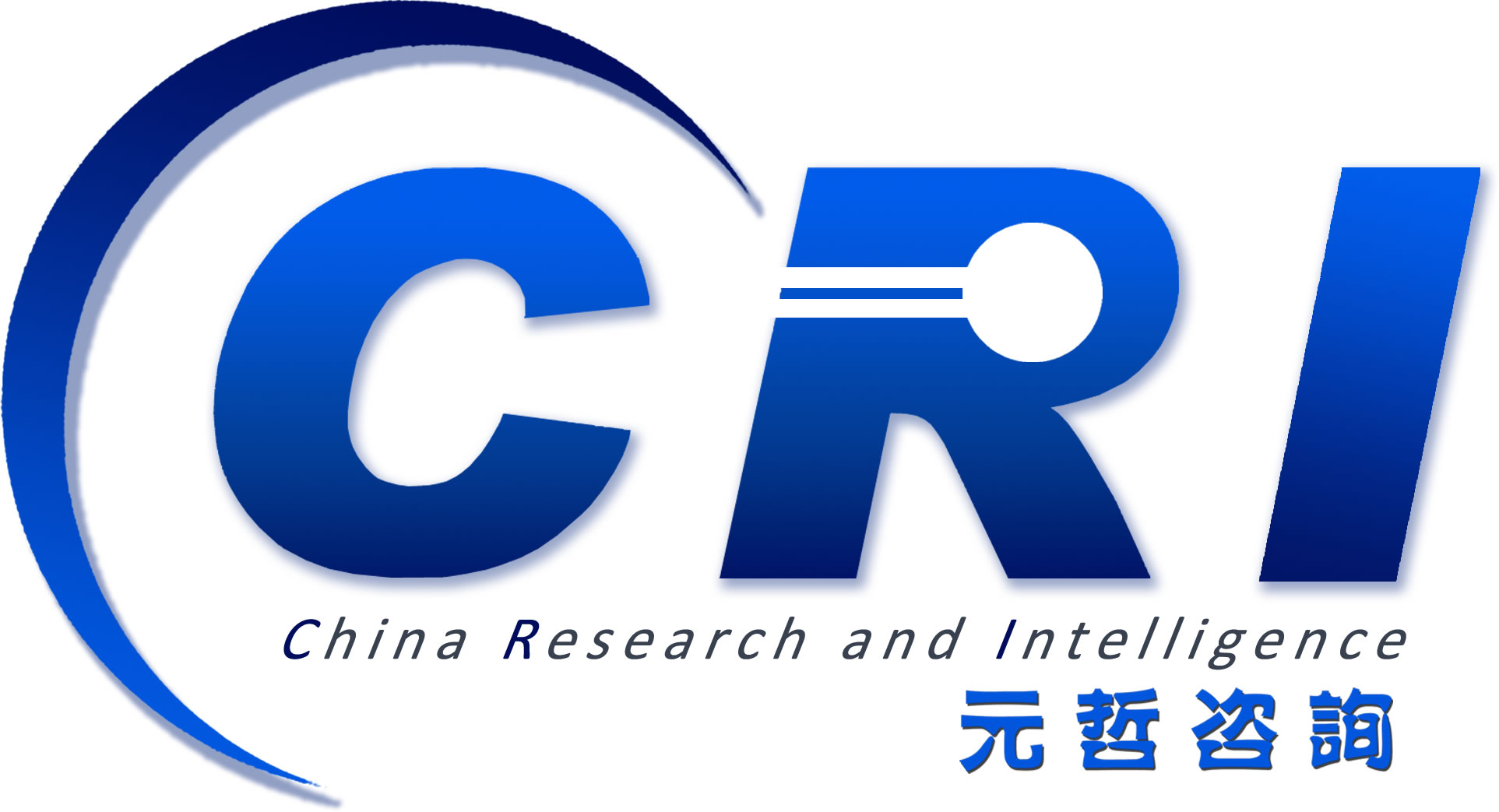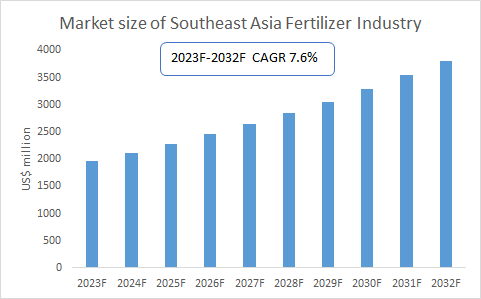Current status of Southeast Asia fertilizer market in 2024
Despite facing some challenges, the fertilizer industry in Southeast Asia is expected to continue to grow. According to the Yuanzhe Consulting report “Southeast Asia Fertilizer Industry Research Report 2023-2032”, the size of the fertilizer market in Southeast Asia will maintain steady growth in 2024. The market size of Southeast Asia’s fertilizer industry will reach US$3.809 billion in 2032, with a compound growth rate of 7.6% from 2023 to 2032.
Market size and trends:
Transport was affected during the initial lockdown due to labor shortages and the closure of fertilizer plants within integrated chemical complexes. Some countries that are highly dependent on imports, such as Myanmar, have been affected by fertilizer shortages, causing the price of imported fertilizers to rise.
However, demand for agricultural fertilizers will continue to grow as Southeast Asian countries expand their agricultural sectors through agricultural diversification and extensive multiple cropping programs.
Demand drivers:
Southeast Asia is one of the world’s largest urea consuming regions, with demand for urea as a direct-applied fertilizer driving consumption growth. Vietnam and Indonesia are the largest consumers of urea in the region.
As the population grows rapidly, the demand for food continues to increase. To increase yields, farmers need adequate fertilizers.
Main products of Southeast Asia fertilizer market
- Nitrogen fertilizer:
Urea: As a direct application fertilizer, urea dominates the Southeast Asia region. Vietnam and Indonesia are the largest consumers of urea in the region. Demand for urea drives consumption growth.
Calcium Ammonium Nitrate (CAN): Also a common nitrogen fertilizer.
Ammonia and ammonium nitrate are also used in the area.
- Phosphate fertilizer:
DAP fertilizer (diammonium phosphate): As one of the main types of phosphate fertilizer, it is used to increase crop productivity. Vietnam and the Philippines are among the major consumers of DAP fertilizer.
- Potash fertilizer:
Potassium fertilizer is essential for crop growth and development. Southeast Asia needs to import approximately 1.3 million tons/year of potassium fertilizer.
- Compound fertilizer:
Compound fertilizers contain a variety of nutrients such as nitrogen, phosphorus and potassium. They play a key role in increasing crop yields.
Myanmar Fertilizer Industry Overview
According to analysis by Yuanzhe Consulting, the lives of most people in Myanmar depend on agriculture and animal husbandry. According to statistics, agriculture accounts for more than 20% of Myanmar’s overall GDP, Myanmar’s agricultural employees account for nearly half of the total employed population, and arable land and forestland account for 16.8% of Myanmar’s total land area. Therefore, the overall trend of Myanmar’s annual fertilizer consumption is rising.
Transport was affected during the initial lockdown due to labor shortages and the closure of fertilizer plants within integrated chemical complexes. Myanmar has been affected by fertilizer shortages, leading to higher prices for imported fertilizers.
The “Myanmar Fertilizer Industry Research Report 2024-2033” predicts that Myanmar’s fertilizer imports will reach 1.93 million tons by 2033, with a compound annual growth rate (CAGR) of 3.2% from 2024 to 2033. For fertilizer production companies and fertilizer trading companies, the Myanmar market has certain market opportunities.
Philippine Fertilizer Industry Overview
According to the research report “Philippine Fertilizer Industry Research Report 2024-2033” by Yuanzhe Consulting, the Philippine fertilizer industry is facing a boom cycle. As the Philippines’ population grows and its economy develops, the demand for chemical fertilizers in agriculture and planting will continue to rise. The Philippines’ fertilizer imports are expected to continue to grow between 2024 and 2033. Yuanzhe Consulting predicts that by 2033, the Philippines’ fertilizer imports will reach 3.39 million tons, with a compound annual growth rate of 3.0%.
In addition, the fertilizer industry throughout Southeast Asia is also showing good development trends. According to analysis by Yuanzhe Consulting, the market size of the fertilizer industry in Southeast Asia will reach US$3.809 billion in 2032, with a compound annual growth rate of 7.6%. Southeast Asia includes ten countries including Singapore, Thailand, Philippines, Malaysia, Indonesia, Vietnam, Myanmar, Brunei, Laos and Cambodia. The total population of this region is close to 700 million, and the overall economic growth rate is higher than the global average, making it one of the important driving forces for future global economic growth.
Indonesia Fertilizer Industry Overview
According to Yuanzhe Consulting’s analysis, farms account for 32% of Indonesia’s total land area, and agricultural production accounts for 14% of the gross domestic product (GDP). Indonesia is also the world’s third largest exporter of cocoa and rubber, and increased export-oriented crop cultivation has led to rising demand for fertilizers in Indonesia.
Yuanzhe Consulting’s “Indonesia Fertilizer Industry Research Report 2024-2033” predicts that with the development of Indonesia’s agriculture and planting industry, Indonesia’s demand for fertilizers will continue to rise from 2024 to 2033. Due to Indonesia’s limited domestic fertilizer production capacity, annual fertilizer imports will continue to rise. Yuanzhe Consulting predicts that Indonesia’s fertilizer imports will reach 7.54 million tons in 2033, with a compound annual growth rate of 3.1% from 2024 to 2033.
Overview of Thailand’s Fertilizer Industry
Agriculture and plantation play a very important role in Thailand’s economic development. In the past 20 years, the proportion of Thailand’s agricultural economy in GDP has been roughly around 8%-10%, and the total annual output value has exceeded 1.5 trillion baht (US$40 billion). Thailand’s fertilizer industry has limited production capacity and requires a large amount of imported fertilizers every year.
According to Yuanzhe Consulting’s analysis, Thailand is a country with an obvious fertilizer trade deficit. Thailand’s annual fertilizer import volume exceeds 4 million tons, but its export volume is only about 500,000 tons. Saudi Arabia, China, Russia, Canada and Malaysia are the top five import sources of fertilizers to Thailand.
The “Thailand Fertilizer Industry Research Report 2024-2033” predicts that with the development of Thailand’s agriculture and planting industry, Thailand’s fertilizer imports will gradually increase in the next few years. Yuanzhe Consulting estimates that Thailand’s fertilizer import volume will be approximately 5.92 million tons in 2033, with a compound annual growth rate of approximately 3.2% from 2024 to 2033.
Overview of Vietnam Fertilizer Industry
Agriculture plays an important role in Vietnam’s economy. The agricultural population accounts for more than 50% of Vietnam’s total population, and arable land and forestland account for 60% of Vietnam’s total land area. According to Yuanzhe Consulting’s analysis, Vietnam’s annual fertilizer exports have exceeded 3 million tons in recent years, while fertilizer imports have also exceeded 1 million tons.
According to Yuanzhe Consulting’s analysis, Vietnam’s fertilizer market concentration is low, with local companies accounting for about 70% of the market share. Based on the overall revenue of the Vietnam fertilizer market in 2023, the top five companies together account for approximately 30% of the market. Major fertilizer manufacturers in the Vietnamese market are adopting various strategies, such as expanding production capacity and finding more distributors, to increase their market share.
The “Vietnam Fertilizer Industry Research Report 2024-2033” predicts that with the development of Vietnam’s agriculture and planting industry, Vietnam’s fertilizer imports will gradually increase in the next few years. Yuanzhe Consulting predicts that Vietnam’s fertilizer imports will reach 6.83 million tons by 2033, with a compound annual growth rate (CAGR) of 5.2% from 2024 to 2033.
*The data listed in this article are for reference only, and the specific situation will vary due to market changes.
If you need to conduct on-site inspections of emerging markets such as Vietnam, Mexico, the Philippines, Thailand, and Indonesia, and participate in a Vietnam investment delegation, you need to conduct local inspections and obtain relevant information such as government policies and market opportunities, or you need assistance in registering companies in Vietnam and Mexico and writing feasibility studies. To research reports, find partners, build factories in Vietnam and Mexico, rent offices, or hire local employees, purchase Vietnamese raw materials, or export products to Vietnam and Mexico, etc., please contact Yuanzhe for consultation.
Yuanzhe Consulting Shanghai Office and Yuanzhe Hanoi Office will serve you wholeheartedly.
Tel: +86-21-6150-9726, +86-21-3326-9308

